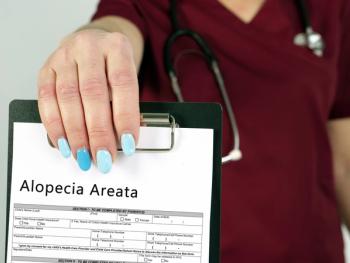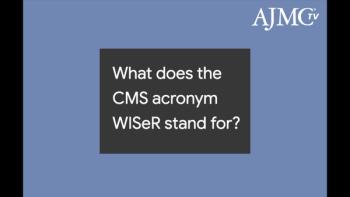
- February 2025
- Volume 31
- Issue Spec. No. 2
- Pages: SP105-SP106
Financial Navigation: Lessons From a Program in Practice

Key Takeaways
- CMS's 2024 update introduced Principal Illness Navigation codes, highlighting the importance of navigation services in cancer care.
- Financial navigation addresses the significant financial challenges and distress faced by cancer patients.
Introduction: The Emergence of Financial Navigation in Cancer Care
Ever since CMS updated its physician fee schedule in 2024 and introduced new reimbursement codes for navigation—the Principal Illness Navigation codes1—a lot of ink has been spilled by various media outlets expounding on the value of such navigation services in furthering health equity in cancer care.
Financial navigation2 is a specific subtype of this broader concept, a system-level intervention that is both an acknowledgment and a response to the fact that the cost of cancer treatment can pose formidable challenges for patients and is a significant enough problem that it necessitates dedicated and trained personnel to address it. Financial toxicity—a term describing the distress and hardship caused by medical expenses—does not suffer from a lack of data describing its extent. Study results showed almost three-fourths of patients reported experiencing serious financial hardship in the first year of diagnosis.3
In addition, patients with cancer are 2.5 times more likely to file for bankruptcy,4 and patients with cancer who go bankrupt are 80% more likely to die than patients who don’t.5 The roots of financial navigation in cancer care trace back to the broader movement toward patient advocacy and holistic care in the late 20th century.6 Initially, financial assistance was often limited to charity care programs or one-off interventions through philanthropic organizations. However, the escalating costs of novel cancer therapies and the growing complexity of health insurance systems led to the need for a structured approach.
Over the years, financial navigation programs have become pivotal in mitigating these challenges7 by providing patients with tailored support to manage their financial responsibilities while accessing lifesaving treatments—inclusive but not limited to finding assistance for medical co-payments; handling nonmedical costs related to care such as transportation, lodging, and meals; managing employment; and navigating disability benefits.
Most comprehensive financial navigation programs, which equitably identify patients at risk and provide assistance proactively, are limited to larger health systems because of resource constraints.8 For example, a 2017 survey of community oncology practices found that less than half of practices had staffed a program to routinely provide patients with this service.9 Thus, this essay presents Tennessee Oncology’s program as a model for other community oncology practices seeking to build or enhance their financial navigation services.
Tennessee Oncology’s Program in Financial Navigation
At Tennessee Oncology, the financial navigation program is not just a nice-to-have benefit for our patients. It is deeply embedded into our strategy and clinical operations, and over time it has become a core component of our success in diverse communities across the state.
Training. Our financial navigators undergo structured training through programs and certifications such as the Association of Cancer Care Centers Financial Advocacy Boot Camp as designated by CMS.10 In addition, they participate in video simulations with patients, proctored field experiences (30 days with a preceptor navigator), and graded role plays with scripting. We have internally developed training modules that familiarize our financial navigators with key health care concepts and our electronic medical record and practice management system. This structured approach allows for consistency, a cornerstone to achieving effectiveness.
Staffing ratios. Different staff help patients with their medical expenses (inclusive of Part B drug spend) and the specialty pharmacy side (for Part D drug spend). The personnel who work to close gaps on the medical expense side are navigators; they almost always have a nursing background. The personnel within the specialty pharmacy are advocates and typically are pharmacy technicians operating under direct pharmacist oversight. In addition to slight variations in educational and training backgrounds, their scopes of work and staffing ratios are also slightly different. Tennessee Oncology’s investment across the practice in this concept is reflected in the staffing ratios of navigators to patients. Each month, our nurse navigators each work with 250 to 300 patients; our financial navigators each work with 300 to 350 patients.
Technology. A hallmark of Tennessee Oncology’s program is its strategic use of technology. Investments have been made in vendors that provide us with financial award availability and tracking software that captures financial data including income, credit scores, and propensity to pay. This information is fully integrated into our electronic medical record and practice management systems, including telemedicine to expand the reach of counselors across our 37 clinic sites and rural patient communities, and data analytics for performance and patient tracking.
Data analytics. These tools, alongside a systematic approach toward data collection and gap analysis, enable navigators to personalize interventions and identify gaps in existing support mechanisms. For example, following the implementation of the validated Hunger Vital Sign11 in 2022, analytics revealed that food insecurity was a critical issue for patients, with many choosing between paying for their groceries or paying the cost-sharing component of their cancer treatment and therefore forgoing necessary treatment.
Programmatic efforts. Data help us think creatively and proactively find solutions for our patients. Although our preference is to connect patients to existing community (local, regional, national) resources, such as the American Cancer Society, Meals on Wheels, Gilda’s Club, and others, in this example, we uncovered a widespread patient need that was not being fully managed by existing programs. We then partnered with local food bank Second Harvest12 to create a program in which food-insecure patients were provided with food boxes for an entire year. In an echo of Project Last Mile13—an initiative in which health care providers leveraged the Coca-Cola company’s supply chain to expand access to HIV and malaria medicines across Africa—Second Harvest ships food boxes by using the courier system that Tennessee Oncology has set up to transport cancer medications to communities across the state.
Systematic approach with a high financial return on investment. At our practice, every patient with out-of-pocket costs has an appointment with a financial counselor to discuss insurance coverage and benefits prior to the start of treatment. If patients are uninsured, navigators refer them to agencies that assist in screening for eligibility for Medicaid and Marketplace plans. We practice in a state that has not expanded Medicaid, and a significant proportion of our patients remain uninsured. Navigators first provide an estimate of patient responsibility; in fact, this is a core component of the Institute of Medicine’s care management plan. They leverage a combination of foundation and grant programs, manufacturer co-pay card programs, manufacturer free-drug programs, and employment and disability benefits to help cover the gap between a patient’s ability to pay after insurance coverage and total cost of care. Our analytics show that each financial navigator typically generates $1 million to $4 million in revenue annually to cover patient out-of-pocket costs, and additional millions in provided drugs for uninsured and underinsured patients. In fact, this revenue generated against the navigator’s salary expense amounts to a stunning 22:1 for infusion drugs, and 85:1 for oral specialty drugs.
Of course, cancer is a long journey, and despite our navigators’ best efforts, patients are not going to always find sources of funding every time they need it. Knowing this—and keeping with our practice’s philosophy to do good and do well—we have a financial hardship policy to forgive unpaid patient balances on the medical benefit spend, and thus we are able to provide indigent care. We do not discriminate against patients who lack insurance, and we do not involve collections agencies over unpaid bills. This policy is the capstone of our entire financial navigation program, and it allows the financial navigation team to remain mission-oriented in their work with patients. Our goal is always to serve our patients first, and at the end of the day, restoring and maintaining patients’ financial health is equally as important as their physical health.
The history of financial navigation in cancer care reflects an ongoing commitment to addressing the economic challenges faced by patients. Tennessee Oncology’s program showcases how a comprehensive, integrated approach can mitigate financial toxicity, improve access to care, and enhance patient outcomes. By adopting similar strategies, other practices can contribute to a more equitable and compassionate oncology care landscape. As the field continues to evolve, financial navigation will undoubtedly remain a critical pillar in achieving health equity for all patients with cancer.
About the Authors
Natalie Dickson, MD, MMHC, FACP, is the president and CEO of Tennessee Oncology, based in Nashville. Samyukta Mullangi, MD, MBA, is a medical oncologist at Tennessee Oncology and senior medical director of oncology at Thyme Care, also based in Nashville.
References
1. Health Equity Services in the 2024 Physician Fee Schedule Final Rule. Medicare Learning Network. US Department of Health and Human Services. January 2024. Accessed January 1, 2025. https://www.cms.gov/files/document/mln9201074-health-equity-services-2024-physician-fee-schedule-final-rule.pdf-0
2. Phillips C. Financial navigation can reduce the financial toxicity of cancer care. National Cancer Institute. April 21, 2023. Accessed January 1, 2025. https://www.cancer.gov/news-events/cancer-currents-blog/2023/cancer-care-financial-navigation-saves-money
3. Shankaran V, Unger JM, Darke AK, et al. A prospective multicenter cooperative group-led study of financial hardship in metastatic colorectal cancer patients. J Natl Cancer Inst. 2022;114(3):372-380. doi:10.1093/jnci/djab210
4. Shankaran V, Li L, Fedorenko C, et al. Risk of adverse financial events in patients with cancer: evidence from a novel linkage between cancer registry and credit records. J Clin Oncol. 2022;40(8):884-891. doi:10.1200/JCO.21.01636
5. Ramsey SD, Bansal A, Fedorenko CR, et al. Financial insolvency as a risk factor for early mortality among patients with cancer. J Clin Oncol. 2016;34(9):980-986. doi:10.1200/JCO.2015.64.6620
6. Freeman HP, Rodriguez RL, The history and principles of patient navigation. Cancer. 2011;117(suppl 15):3539-3542. doi:10.1002/cncr.26262
7. Offodile AC 2nd, Gallagher K, Angove R, Tucker-Selley RD, Balch A, Shankaran V. Financial navigation in cancer care delivery: state of the evidence, opportunities for research, and future directions. J Clin Oncol. 2022;40(21):2291-2294. doi:10.1200/JCO.21.02184
8. de Moor JS, Mollica M, Sampson A, et al. Delivery of financial navigation services within National Cancer Institute-designated cancer centers. JNCI Cancer Spectr. 2021;5(3):pkab033, doi:10.1093/jncics/pkab033
9. Bell-Brown A, Watabayashi K, Delaney D, et al. Assessment of financial screening and navigation capabilities at National Cancer Institute community oncology clinics. JNCI Cancer Spectr. 2023;7(5):pkad055. doi:10.1093/jncics/pkad055
10. Powerful training to boost your financial advocacy skills. Association of Cancer Care Centers. Accessed January 1, 2025. https://www.accc-cancer.org/home/learn/financial-advocacy/boot-camp
11. Gattu RK, Paik G, Wang Y, Ray P, Lichenstein R, Black MM. The Hunger Vital Sign identifies household food insecurity among children in emergency departments and primary care. Children (Basel). 2019;6(10):107. doi:10.3390/children6100107
12. Nourishing local communities. Second Harvest Food Bank. Accessed January 1, 2025. https://www.secondharvestmidtn.org/
13. Project Last Mile. The Coca-Cola Company. Accessed January 1, 2025. https://www.coca-colacompany.com/social/project-last-mile
Articles in this issue
Newsletter
Stay ahead of policy, cost, and value—subscribe to AJMC for expert insights at the intersection of clinical care and health economics.















































